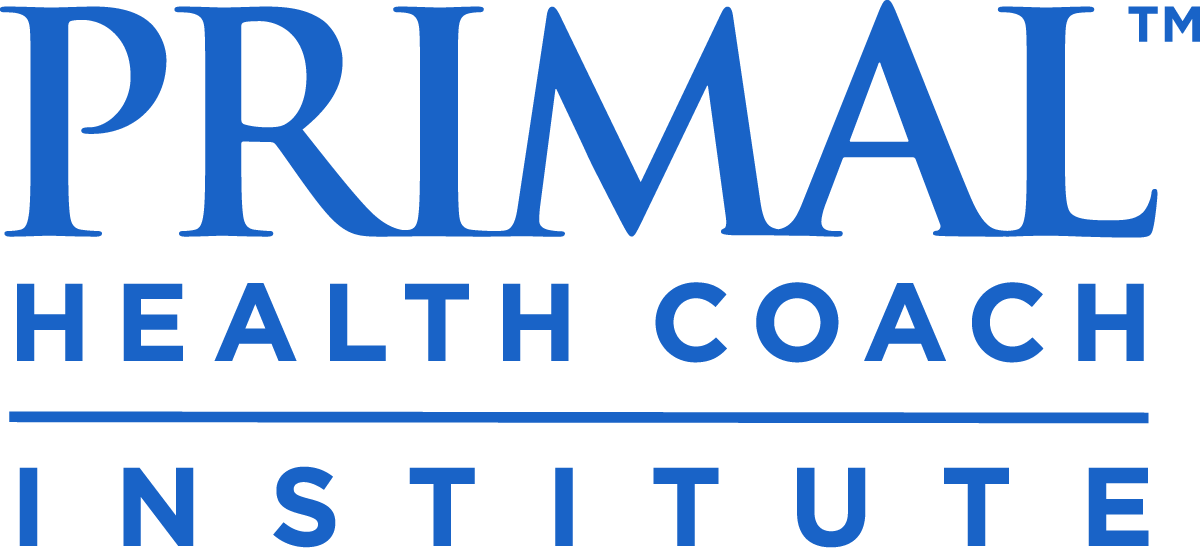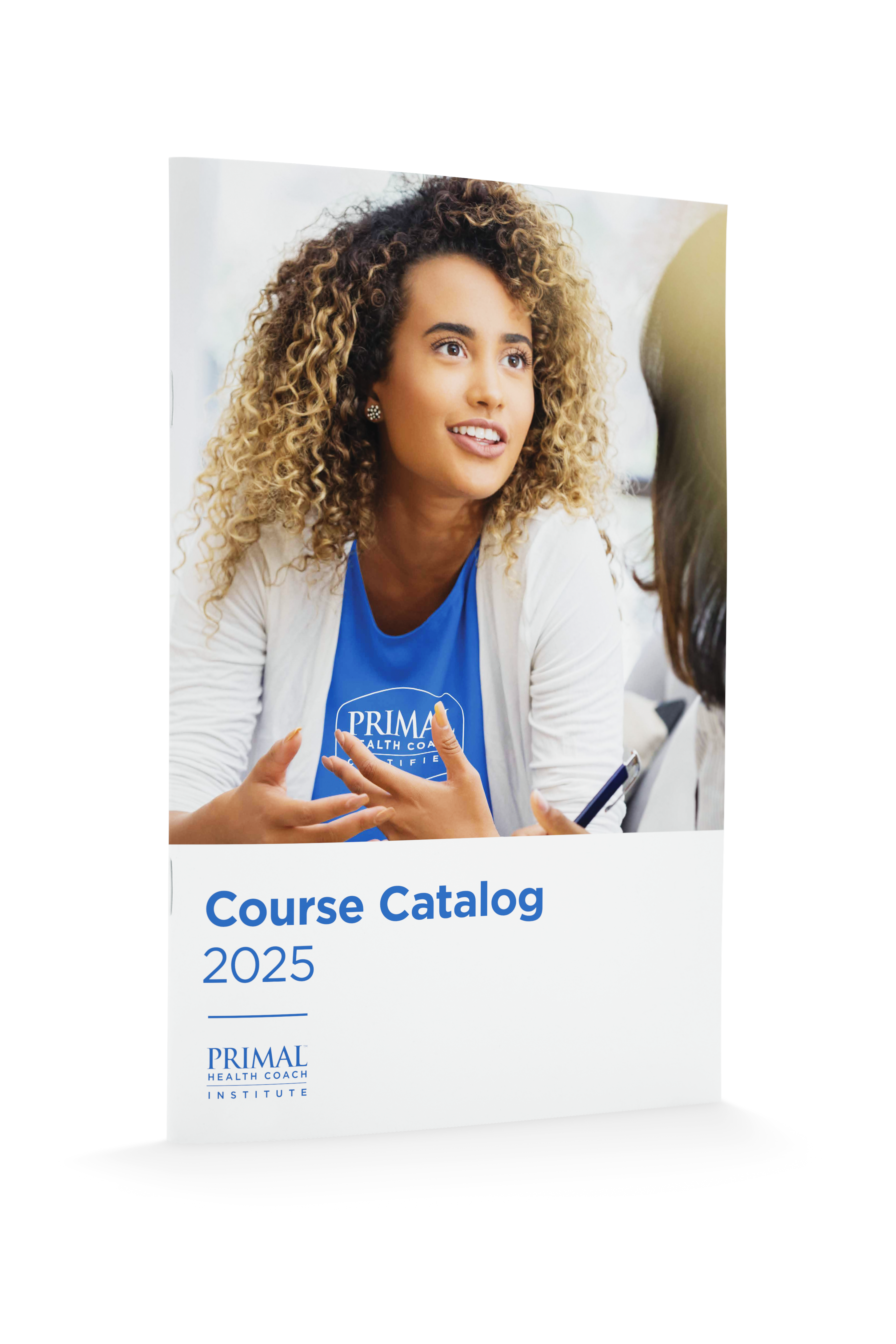
The health coaching industry is growing rapidly, and that means the number of opportunities for coaches is multiplying, too. There are over 400,000 health-focused apps available today, and new mHealth startups are looking to add coaches like you to their team. mHealth stands for mobile health, and it represents all health-related categories like fitness, medicine, nutrition, wellness, etc…
Are you beginning to imagine all of the job opportunities out there for coaches?
Further opportunities include healthcare software companies, corporate health programs, and telehealth physicians (who now offer telemedicine). Many of these groups are building a collaborative care model, with allied professionals like health coaches and dietitians, to help their patients put diet and lifestyle recommendations into a plan that works.
Even as a self-employed health coach, it’s common to seek out part-time and remote job opportunities to increase income and grow our experience in the field. In December of 2019, I started looking for remote coaching opportunities myself. I searched on Linkedin, Indeed, and Upwork; and I was pleasantly surprised by all of the possibilities.
The only problem was that my resume was in need of a major update. I turned to my friend Miranda Morley, a Certified Professional Resume Writer, for answers. She specializes in resume writing and career coaching at Morley Career Solutions, and she’s a community leader at GreenCow, a membership organization that helps professionals succeed.
Here’s what I learned about the top ways to optimize a health coach’s resume for jobs in 2020:
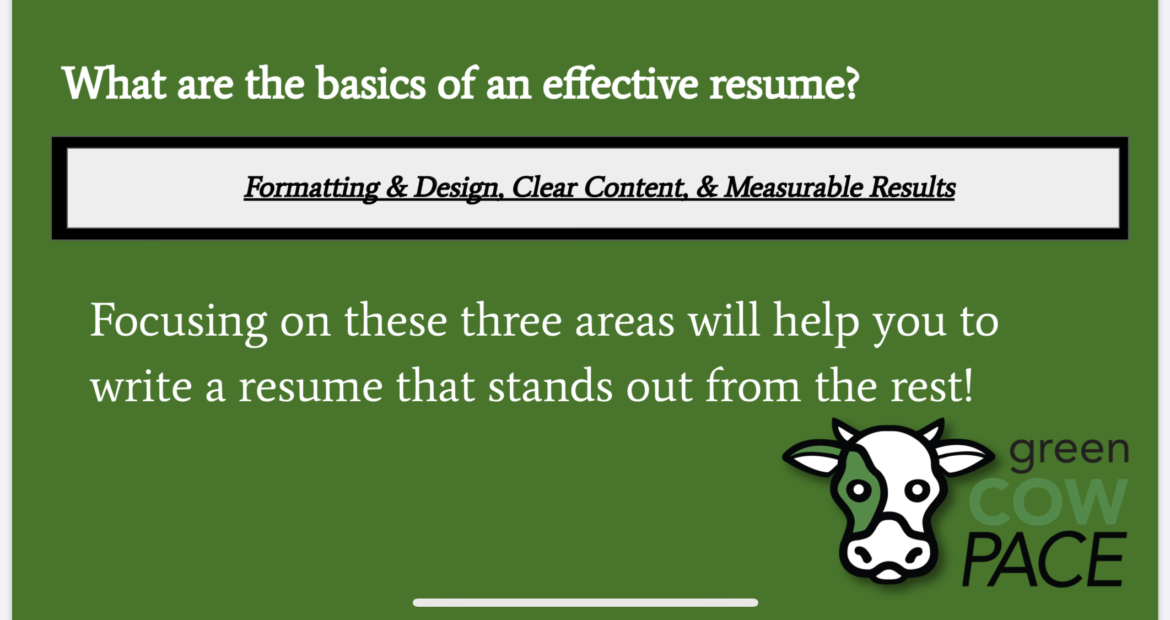
When working on a new resume, Miranda urges us to get these three basics down:
- Formatting & Design
- Clear Content
- Measurable Results
Let’s dive in…
1. Formatting & Design
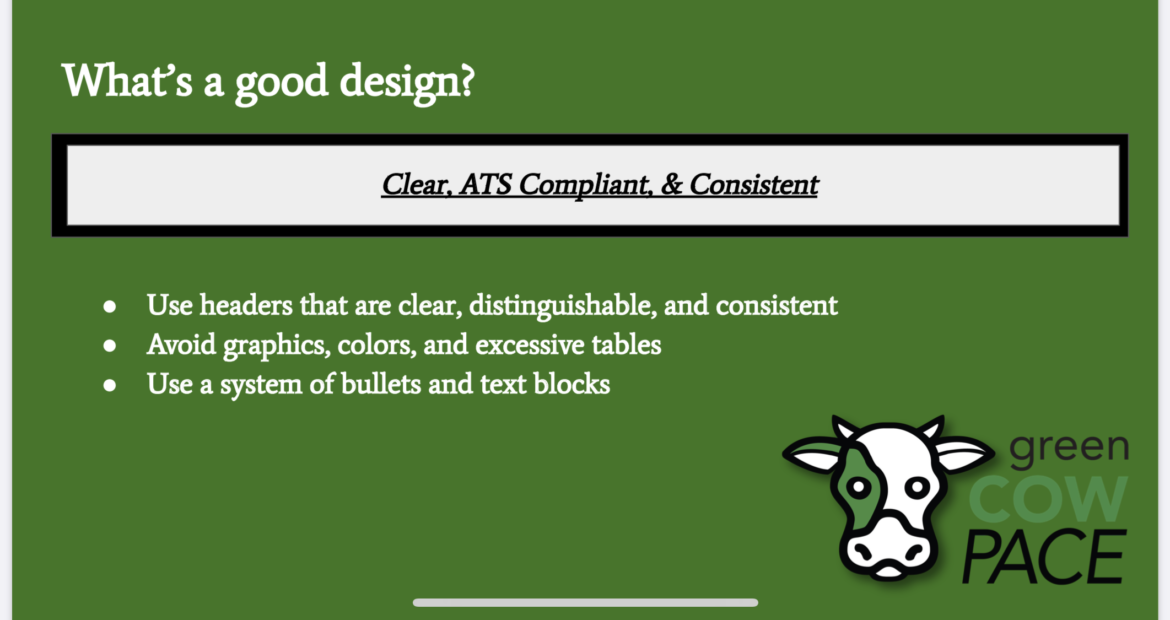
Design is really important, but not in the ways you might imagine. Some people get really creative with the design these days because they’re trying to stand out. Miranda explained that a good design isn’t necessarily stylish at all; it is ATS-compliant—or it may never make it through the ATS automation (Applicant Tracking Systems used by recruiters to process resumes and applications).
How common is ATS technology?
Miranda says they are fairly common because most businesses use a third party to manage their applications (third parties like Linkedin, CareerBuilder, Indeed, etc..).
If they’re using those websites, they’re using ATS. Regardless, many businesses are now requiring that resumes are run through ATS to save them time and frustration during the application process.
A good design is: clear and consistent; and without graphics, colors, photos, or excessive tables/borders.
Use bullets and text boxes, along with effective formatting, to make it easier for employers to quickly find the key information they’re looking for. This is important, Miranda said, “because a good design is part of your strategy when changing careers,” and it helps the recruiter see you in a certain light.
2. Clear Content
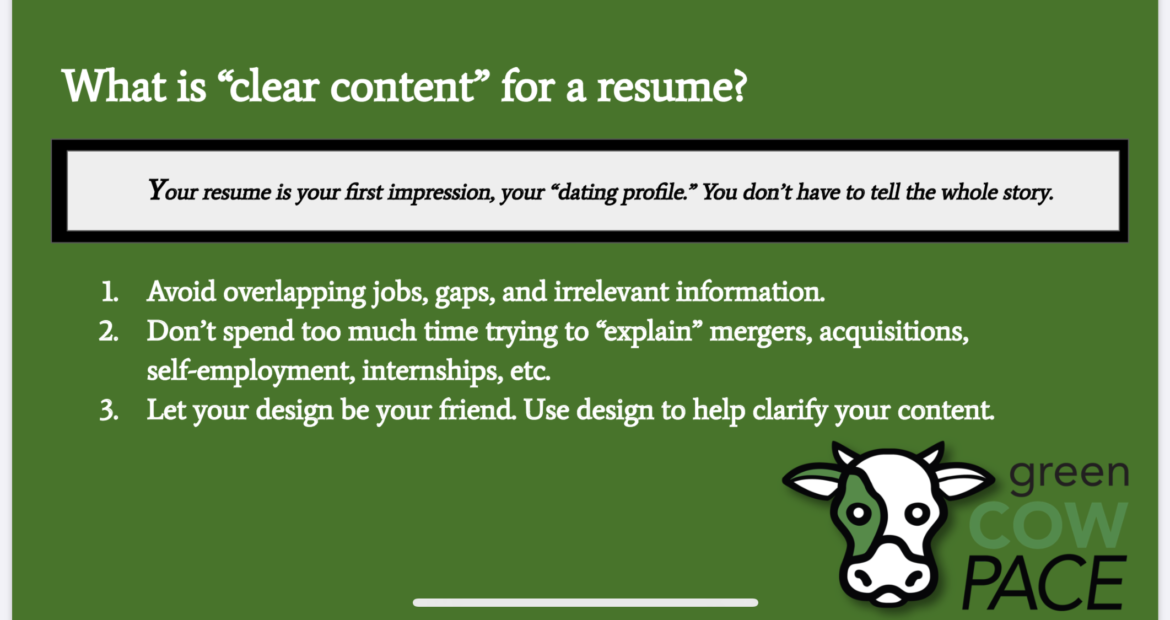
You may be tempted to cram in your entire work history (or education history), but Miranda says, “it’s important to leave out any irrelevant info, overlapping jobs, and gaps” because they detract from an effective resume.
It is good to leave out jobs that don’t serve the position you’re going for, but never eliminate experiences that leave you with a gap in the last couple of years (if the gap is around 10 years ago, that is fine).
I asked Miranda, “What do you mean by overlapping jobs?”
She explained that overlapping jobs are when you work at more than one company in a short time frame. This makes your resume hard to read, and ATS doesn’t like it at all.
“If you’re applying for a 9-5, overlapping jobs will raise red flags—are they going to quit after the first paycheck? Sometimes, unrelated experience can give you an advantage, but you have to be selective or strategic—what should we include or combine, in which order? But, every job should be listed in reverse chronological order—no matter what.”
She went on to emphasize that you should never use a Functional Resume because “employers hate them, and ATS dismisses them.”
To help ensure that your resume is clearly organized and written, be sure to use classic headers like “professional experience” and “education” (instead of getting creative), so your resume gets through those automation systems.
Here’s an example of the headers and formatting Miranda used in my resume:
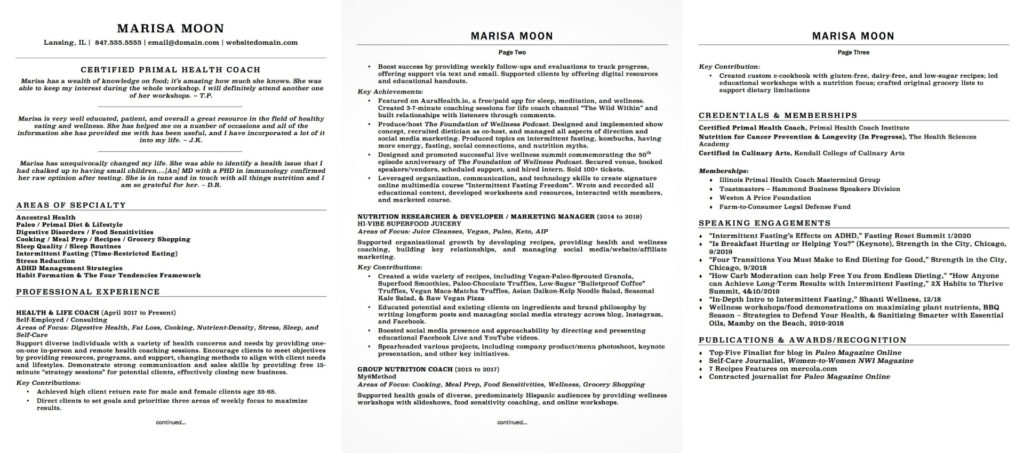
Next, I asked, “How do you best display self-employment?”
Start with your title such as Health Coach (or Fitness Coach, whatever describes your main title). “Your title should not be Owner,” Miranda said, because ATS searches for relevant titles.
Below your title, list your business name or “Self-Employed/Consulting.” This is good if your business is your name.
“There are lots of different ways to do it depending on your design and content needs; it really kind of depends on what you want to achieve and who is going to be reading your resume.”
If you’re new to health coaching, you’re probably changing industries entirely. Miranda explains, “Sometimes when you’re transitioning, the fact that you’re changing industries can be an advantage because trends now demonstrate that employers don’t like cookie-cutter employees. The more diverse your experience, the more likely you are to be able to connect with a diverse range of people, and problem-solve in unique situations. The trick is to highlight your previous career as an asset rather than a drawback: How is my experience going to help this company to achieve their goals?”
3. Measurable Results
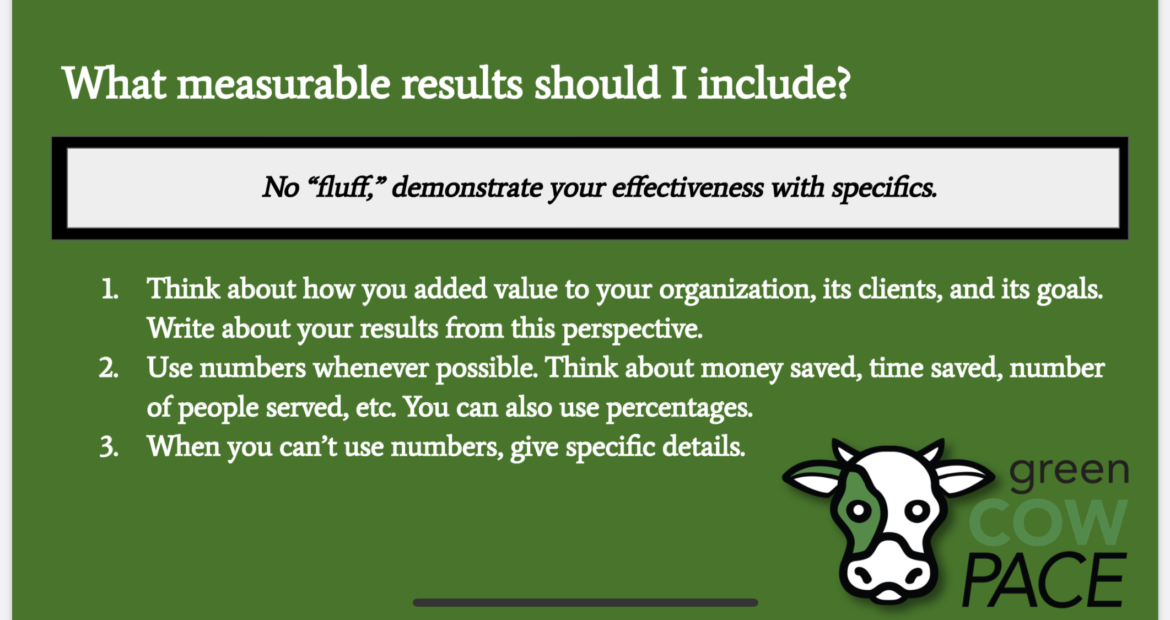
“Your resume is the place for evidence,” said Miranda. “Think about how you added value to your organization or clients in relation to goals, return on investment, and mission. Write about your results from this perspective.”
Use numbers whenever possible to demonstrate how effective you were at your job. “Think about money or time saved, number of people you served, how big the customer base was, how many times you answered the phones, etc…numbers translate really well in ATS.”
Your numbers might not be high when you’re new, but using a percentage shows the actual impact you had (without the straightforward numbers). Example: Maybe you only had 5 clients this year, but you retained 100% of those clients. You can even send out client satisfaction surveys to capture your client satisfaction rate. How great would it look if you shared a 100% client satisfaction rate?
Final Bits of Advice
What are some of the biggest mistakes coaches can make right now when crafting their new resumes?
Miranda said, plain and simple, “Leaving out the specifics (accomplishments and key contributions), and formatting their own self-employment ineffectively.”
Which are the top job search websites right now?
Flexjobs allows you to look for positions that are “flex” like remote, travel, and part-time. “This may be a good time for health coaches to be searching for flex jobs because so many businesses are more willing to hire remotely now. Zip Recruiter is also good. Indeed and LinkedIn are good free ones, too. “
How important is it to have a Linkedin profile?
Miranda said, “You wouldn’t ask me how important is it to have a resume…that’s really what Linkedin is becoming; it’s almost more important than a resume now. Sometimes the Linkedin profile is what makes the recruiter call you. Build the Linkedin profile before you start job searching—even if you just add basic information and a photo, it’s better than not having anything. Social media pages are great, but employers will wonder why you don’t have a Linkedin profile or connections.
One last tip? “Remember to tweak your resume every time you apply for a new position to tailor your messaging to the job requirements and characteristics.” Miranda helps service-based business owners like us work on their resumes every Monday in the GreenCOW career chat. Professional help is always around the corner.
